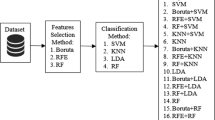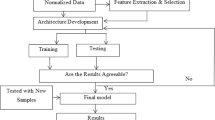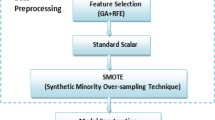Abstract
In this paper, some significant efforts on fuzzy oblique decision tree (FODT) have been done to improve classification accuracy and decrease tree size. Firstly, to eliminate data redundancy and improve classification efficiency, a forward greedy fast feature selection algorithm based on neighborhood rough set (NRS_FS_FAST) is introduced. Then, a new fuzzy rule generation algorithm (FRGA) is proposed to generate fuzzy rules. These fuzzy rules are used to construct leaf nodes for each class in each layer of the FODT. Different from the traditional axis-parallel decision trees and oblique decision trees, the FODT takes dynamic mining fuzzy rules as decision functions. Moreover, the parameter δ, which can control the size of the tree, is optimized by genetic algorithm. Finally, a series of comparative experiments are carried out with five traditional decision trees (C4.5, Best First Tree (BFT), amulti-class alternating decision tree (LAD), Simple Cart (SC), Naive Bayes Tree (NBT)), and recently proposed decision trees (FRDT, HHCART, and FMMDT-HB) on UCI machine learning datasets. The experimental results demonstrate that the FODT exhibits better performance on classification accuracy and tree size than the chosen benchmarks.













Similar content being viewed by others
References
Cover T, Hart P (2002) Nearest neighbor pattern classification[J]. IEEE Trans Inf Theory 13(1):21–27
Medin DL, Schaffer MM (2016) Context theory of classification learning[J]. Psychol Rev 85(3):207–238
Tsang ECC, Chen D, Yeung DS et al (2008) Attributes reduction using fuzzy rough sets[J]. IEEE Trans Fuzzy Syst 16(5):1130–1141
Jing Y, Li T, Fujita H et al (2017) An incremental attribute reduction approach based on knowledge granularity with a multi-granulation view[J]. Inf Sci 411:23–38
Zhang DW, Wang P, Qiu JQ et al (2010) An improved approach to feature selection[C]. In: Machine learning and cybernetics (ICMLC), 2010 international conference on, vol 1. IEEE, pp 488–493
Liu ZG, Pan Q, Dezert J (2014) A belief classification rule for imprecise data[J]. Appl Intell 40(2):214–228
Afify AA (2016) A fuzzy rule induction algorithm for discovering classification rules[J]. J Intell Fuzzy Syst 30(6):3067–3085
Park SB, Zhang BT, Kim YT (2003) Word sense disambiguation by learning decision trees from unlabeled data[J]. Appl Intell 19(1–2):27–38
Li XB, Sweigart J, Teng J et al (2001) A dynamic programming based pruning method for decision trees[J]. INFORMS J Comput 13(4):332–344
Wu CC, Chen YL, Liu YH et al (2016) Decision tree induction with a constrained number of leaf nodes[J]. Appl Intell 45(3):673–685
Quinlan JR (2014) C4.5: programs for machine learning[M]. Elsevier, New York
Liang C, Zhang Y, Shi P et al (2015) Learning accurate very fast decision trees from uncertain data streams[J]. Int J Syst Sci 46(16):3032–3050
Sok HK, Ooi MPL, Kuang YC et al (2016) Multivariate alternating decision trees[J]. Pattern Recogn 50:195–209
Kumar PSJ, Yung Y, Huan TL (2017) Neural network based decision trees using machine learning for Alzheimer’s diagnosis[J]. Int J Comput Inform Sci 4(11):63–72
Shukla SK, Tiwari MK (2012) GA guided cluster based fuzzy decision tree for reactive ion etching modeling: a data mining approach[J]. IEEE Trans Semicond Manuf 25(1):45–56
Liu X, Feng X, Pedrycz W (2013) Extraction of fuzzy rules from fuzzy decision trees: an axiomatic fuzzy sets (AFS) approach[J]. Data Knowl Eng 84:1–25
Wang X, Liu X, Pedrycz W et al (2015) Fuzzy rule based decision trees[J]. Pattern Recogn 48(1):50–59
Segatori A, Marcelloni F, Pedrycz W (2018) On distributed fuzzy decision trees for big data[J]. IEEE Trans Fuzzy Syst 26(1):174–192
Tan PJ, Dowe DL (2006) Decision forests with oblique decision trees[C]. In: Mexican international conference on artificial intelligence. Springer, Berlin, pp 593–603
Barros RC, Jaskowiak PA, Cerri R et al (2014) A framework for bottom-up induction of oblique decision trees[J]. Neurocomputing 135:3–12
Do TN, Lenca P, Lallich S (2015) Classifying many-class high-dimensional fingerprint datasets using random forest of oblique decision trees[J]. Vietnam journal of computer science 2(1):3–12
Wickramarachchi DC, Robertson BL, Reale M et al (2016) HHCART: An oblique decision tree[J]. Comput Stat Data Anal 96:12–23
Rivera-Lopez R, Canul-Reich J, Gómez JA et al (2017) OC1-DE: a differential evolution based approach for inducing oblique decision trees[C]. In: International conference on artificial intelligence and soft computing. Springer, Cham, pp 427–438
Rivera-Lopez R, Canul-Reich J (2017) A global search approach for inducing oblique decision trees using differential evolution[C]. In: Canadian conference on artificial intelligence. Springer, Cham, pp 27–38
Narayanan SJ, Paramasivam I, Bhatt RB et al (2015) A study on the approximation of clustered data to parameterized family of fuzzy membership functions for the induction of fuzzy decision trees[J]. Cybernetics and Information Technologies 15(2):75–96
Han NM, Hao NC (2016) An algorithm to building a fuzzy decision tree for data classification problem based on the fuzziness intervals matching[J]. Journal of Computer Science and Cybernetics 32(4):367–380
Sardari S, Eftekhari M, Afsari F (2017) Hesitant fuzzy decision tree approach for highly imbalanced data classification[J]. Appl Soft Comput 61:727–741
Ludwig SA, Picek S, Jakobovic D (2018) Classification of Cancer data: analyzing gene expression data using a fuzzy decision tree algorithm[M]. In: Operations research applications in health care management. Springer, Cham, pp 327–347
Manwani N, Sastry PS (2012) Geometric decision tree[J]. IEEE Trans Syst Man Cybern B Cybern 42(1):181–192
Patil SP, Badhe SV (2015) Geometric approach for induction of oblique decision tree[J]. International Journal of Computer Science and Information Technologies 5(1):197–201
Cant-Paz E, Kamath C (2000) Using evolutionary algorithms to induce oblique decision trees[C]. In: Proceedings of the 2nd annual conference on genetic and evolutionary computation. Morgan Kaufmann Publishers Inc, pp 1053–1060
Skowron A (2000) Rough sets in KDD[J]. Special invited speaking, WCC pp 1–17
Zhang-Yan XU, Hou W, Song W et al (2009) Efficient heuristic attribute reduction algorithm based on information entropy[J]. Journal of Chinese Computer Systems 30(9):1805–1810
Yang SM, Jie M, Zhang ZB et al (2015) An improved heuristic attribute reduction algorithm based on information entropy in rough set[J]. Open Cybernetics & Systemics Journal 9(1):2774–2779
Guang-Yuan FU, Han-Zhao WU, Yang XG (2013) Attribute reduction algorithm of rough set based on the combined compatibility and importance of attributes[J]. Science Technology & Engineering
Zadeh LA (1997) Toward a theory of fuzzy information granulation and its centrality in human reasoning and fuzzy logic[J]. Fuzzy Sets Syst 90(2):111–127
Agrawal R, Imielinski T, Swami A (1993) Database mining: a performance perspective[J]. IEEE Trans Knowl Data Eng 5(6):914–925
Wang X, Liu X, Pedrycz W et al (2012) Mining axiomatic fuzzy set association rules for classification problems[J]. Eur J Oper Res 218(1):202–210
Shi H (2007) Best-first decision tree learning[D]. The University of Waikato
Holmes G, Pfahringer B, Kirkby R et al (2002) Multiclass alternating decision trees[C]. In: European conference on machine learning. Springer, Berlin, pp 161–172
Breiman LI, Friedman JH, Olshen RA et al (1984) Classification and regression trees (CART)[J]. Encyclopedia of Ecology 40(3):582–588
Kohavi R (1996) Scaling up the accuracy of naive-Bayes classifiers: a decision-tree hybrid[C]. In: KDD 96, pp 202–207
Mirzamomen Z, Kangavari MR (2017) A framework to induce more stable decision trees for pattern classification[J]. Pattern Anal Applic 20(4):991–1004
Asuncion A, Newman D (2007) UCI machine learning repository[J]. http://www.ics.uci.edu/mlearn/MLRepository.html. Accessed 26 Jan 2018
http://stanford.edu/marinka/nimfa/nimfa.datasets.html. Accessed 28 July 2018
Witten LH, Frank E, Hall MA (2011) Data mining: practical machine learning tools and techniques, third edition[J]. ACM SIGMOD Rec 31(1):76–77
Hhn JC, Hllermeier E (2009) FR3: a fuzzy rule learner for inducing reliable classifiers[J]. IEEE Trans Fuzzy Syst 17(1):138–149
Acknowledgements
This work was supported by the National Natural Science Foundation of China (61627809, 61433004, 61621004), and Liaoning Revitalization Talents Program (XLYC1801005).
Author information
Authors and Affiliations
Corresponding author
Additional information
Publisher’s note
Springer Nature remains neutral with regard to jurisdictional claims in published maps and institutional affiliations.
Rights and permissions
About this article
Cite this article
Cai, Y., Zhang, H., He, Q. et al. A novel framework of fuzzy oblique decision tree construction for pattern classification. Appl Intell 50, 2959–2975 (2020). https://doi.org/10.1007/s10489-020-01675-7
Published:
Issue Date:
DOI: https://doi.org/10.1007/s10489-020-01675-7




